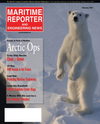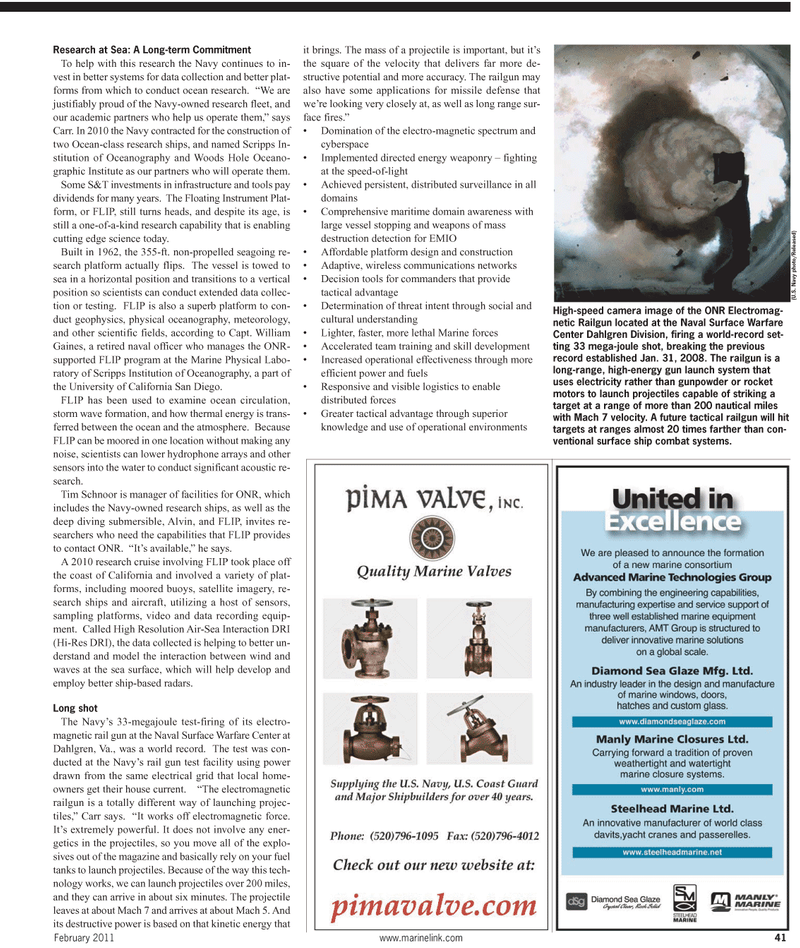
Page 41: of Maritime Reporter Magazine (February 2011)
Cruise & Passenger Vessel Annual
Read this page in Pdf, Flash or Html5 edition of February 2011 Maritime Reporter Magazine
Research at Sea: A Long-term Commitment
To help with this research the Navy continues to in- vest in better systems for data collection and better plat- forms from which to conduct ocean research. “We are justifiably proud of the Navy-owned research fleet, and our academic partners who help us operate them,” says
Carr. In 2010 the Navy contracted for the construction of two Ocean-class research ships, and named Scripps In- stitution of Oceanography and Woods Hole Oceano- graphic Institute as our partners who will operate them.
Some S&T investments in infrastructure and tools pay dividends for many years. The Floating Instrument Plat- form, or FLIP, still turns heads, and despite its age, is still a one-of-a-kind research capability that is enabling cutting edge science today.
Built in 1962, the 355-ft. non-propelled seagoing re- search platform actually flips. The vessel is towed to sea in a horizontal position and transitions to a vertical position so scientists can conduct extended data collec- tion or testing. FLIP is also a superb platform to con- duct geophysics, physical oceanography, meteorology, and other scientific fields, according to Capt. William
Gaines, a retired naval officer who manages the ONR- supported FLIP program at the Marine Physical Labo- ratory of Scripps Institution of Oceanography, a part of the University of California San Diego.
FLIP has been used to examine ocean circulation, storm wave formation, and how thermal energy is trans- ferred between the ocean and the atmosphere. Because
FLIP can be moored in one location without making any noise, scientists can lower hydrophone arrays and other sensors into the water to conduct significant acoustic re- search.
Tim Schnoor is manager of facilities for ONR, which includes the Navy-owned research ships, as well as the deep diving submersible, Alvin, and FLIP, invites re- searchers who need the capabilities that FLIP provides to contact ONR. “It’s available,” he says.
A 2010 research cruise involving FLIP took place off the coast of California and involved a variety of plat- forms, including moored buoys, satellite imagery, re- search ships and aircraft, utilizing a host of sensors, sampling platforms, video and data recording equip- ment. Called High Resolution Air-Sea Interaction DRI (Hi-Res DRI), the data collected is helping to better un- derstand and model the interaction between wind and waves at the sea surface, which will help develop and employ better ship-based radars.
Long shot
The Navy’s 33-megajoule test-firing of its electro- magnetic rail gun at the Naval Surface Warfare Center at
Dahlgren, Va., was a world record. The test was con- ducted at the Navy’s rail gun test facility using power drawn from the same electrical grid that local home- owners get their house current. “The electromagnetic railgun is a totally different way of launching projec- tiles,” Carr says. “It works off electromagnetic force.
It’s extremely powerful. It does not involve any ener- getics in the projectiles, so you move all of the explo- sives out of the magazine and basically rely on your fuel tanks to launch projectiles. Because of the way this tech- nology works, we can launch projectiles over 200 miles, and they can arrive in about six minutes. The projectile leaves at about Mach 7 and arrives at about Mach 5. And its destructive power is based on that kinetic energy that it brings. The mass of a projectile is important, but it’s the square of the velocity that delivers far more de- structive potential and more accuracy. The railgun may also have some applications for missile defense that we’re looking very closely at, as well as long range sur- face fires.” • Domination of the electro-magnetic spectrum and cyberspace • Implemented directed energy weaponry – fighting at the speed-of-light • Achieved persistent, distributed surveillance in all domains • Comprehensive maritime domain awareness with large vessel stopping and weapons of mass destruction detection for EMIO • Affordable platform design and construction • Adaptive, wireless communications networks • Decision tools for commanders that provide tactical advantage • Determination of threat intent through social and cultural understanding • Lighter, faster, more lethal Marine forces • Accelerated team training and skill development • Increased operational effectiveness through more efficient power and fuels • Responsive and visible logistics to enable distributed forces • Greater tactical advantage through superior knowledge and use of operational environments
February 2011 www.marinelink.com 41 (U.S. Navy photo/Released)
High-speed camera image of the ONR Electromag- netic Railgun located at the Naval Surface Warfare
Center Dahlgren Division, firing a world-record set- ting 33 mega-joule shot, breaking the previous record established Jan. 31, 2008. The railgun is a long-range, high-energy gun launch system that uses electricity rather than gunpowder or rocket motors to launch projectiles capable of striking a target at a range of more than 200 nautical miles with Mach 7 velocity. A future tactical railgun will hit targets at ranges almost 20 times farther than con- ventional surface ship combat systems.

 40
40

 42
42
